Agricultural and Biological Research
RNI # 24/103/2012-R1
Research Article - (2024) Volume 40, Issue 3
Species of fungi that belong to the genus Trichoderma produce a variety of secondary metabolites with different valuable function including biocontrol and growth promotion activity. In this study, T. yunnanense was tested for their effect on plant diseases caused by Fusarium, Alternaria, Penicillium and Aspergillus in dual culture method. Six secondary metabolites were extracted from T. yunnanense and tested against different fungal pathogens. It was observed that secondary metabolites having Rf value 0.76 showed the highest inhibition percentage of mycelial growth and germination of pathogen followed by 0.66 and 0.53. It was also illustrated that, application of T. yunnanense after mass multiplication using different agriculture waste products such as coconut peat, rice husk, sugarcane bagasse and tamarind seeds increases the overall growth of tomato plant. These results clearly indicate that T. yunnanense may have a role in both plant defense responses and plant growth promotion activity. This is the first report of biocontrol and growth promotion activity of T. yunnanense from Bihar.
T. ynnanense; Secondary metabolites; Mass multiplication; Growth promotion; Biocontrol
The main issue in agriculture is the reduction in crop production caused by multiple damaging actions of pests and pathogens. The use of chemicals to minimize these infections harm the ecosystem, reduces soil productivity and pollute our air and water resources. People desire pesticide-free food because of the numerous negative effects of chemical pesticides on human health [1]. Some microorganisms have been found as an eco-friendly alternative for biological control of plant diseases instead of chemicals [2].
Trichoderma genus is considered as promising biocontrol agent against multiple soil-borne phytopathogenic fungi. It inhibits the pathogen growth by inducing plant defense response or by mycoparasitism and competition. Trichoderma, a saprophytic fungus that is known for easily colonizing in rhizosphere of plant, may also aid in promoting plant growth [3]. Members of Trichoderma genus shows antagonistic efficacy against numerous disease causing pathogens such as Alternaria, Fusarium, Aspergillus, Phytophthora and Rhizoctonia. The mycelium of Trichoderma can produce a variety of enzymes, including chitinase and cellulase which can degrade chitin and cellulose respectively. Cellulase is an enzyme that works in concert with other enzymes to break down cellulose into glucose or other oligosaccharide compounds. Thus, Trichoderma could be manufactured in large quantities for commercial purposes [4].
Mass production of bio-control agent must be inexpensive. The commercialization of fungal bio-control agents has been severely hindered by a variety of factors, including production methods and raw material costs. So, it is important to find out suitable and cost effective way for their production [5]. Many researchers are searching for low-cost raw materials like waste water sludge Verma, et al. and agricultural residues to address these shortcomings [6].
The purpose of the current study was to evaluate the effectiveness of native Trichoderma isolates against various fungal pathogens. Different agro-waste products for biomass production of Trichoderma under in vitro condition and its efficacy for plant growth promotion activity were also tested. Eventually, this study will help in scale-up of the process to pilot scale and finally results into a large-scale production [7]. In addition, use of agro-waste materials for mass scale production of bio-control agent will serve dual purpose:
• Reduction of agricultural waste pollution. • Eco-friendly management of fungal diseases.
Isolation of microbes
Organs with typical disease symptoms served as the source of Fusarium solani isolates in potato, Alternaria brassicae from cabbage, Aspergillus flavus and Penicillium notatum from soil. Samples of rhizospheric soil were taken at a depth of 15 cm from different crop fields for isolation of Trichoderma. Seven distinct species of Trichoderma were isolated from various locations of Patna, Nalanda, Ara and Gaya district of Bihar where Trichoderma yunnanense was isolated from three different sites (Murajpur, Gulmahiyabagh and Jethuli) of Patna district [8]. Samples were inoculated on Potato Dextrose Agar (PDA) media with 0.05 gm chloramphenicol to reduce bacterial growth by serial dilution method. For this, 25 g m of soil were added to 250 ml of distilled water and transfer 10 ml of this dilution to 90 ml of distilled water and repeat this process till the dilution up to 10-3. Transfer 1 ml of 10-3 and 10-4 dilution to sterile petri plates containing PDA media. The plates were incubated at 27℃ ± 2℃ for 5 days. Different fungal colony which were grown on PDA media were picked and inoculated separately on PDA media [9].
Morphological identification and culture preservation
Colony morphology and microscopic analysis were used to identify Trichoderma and all phytopathogens with the help of authentic laboratory manual of Barnett and Hunter (Figure 1) [10]. Fungal species were preserved on PDA slant at 4°C. Grown on PDA plate at 27℃ ± 2℃ for 7 days when they were needed and spores were harvested from fully grown colony with the help of sterile spatula and stored in a small air tight vial in refrigerator at 4℃ for further studies [11]. Spore suspension of 106 spores/ml was prepared in water with 0.05% tween 80.
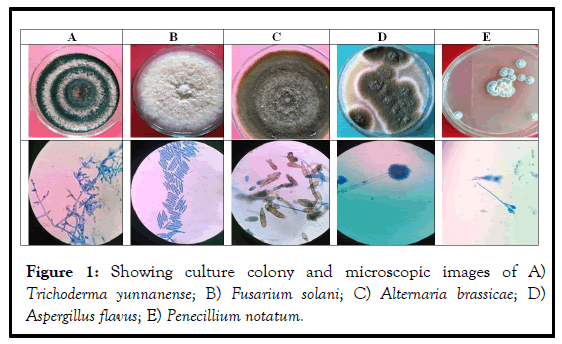
Figure 1: Showing culture colony and microscopic images of A) Trichoderma yunnanense; B) Fusarium solani; C) Alternaria brassicae; D) Aspergillus flavus; E) Penecillium notatum.
Molecular identification and phylogenetic analysis of Trichoderma by amplication of Internal Transcribed Spacer (ITS) region
DNA was extracted from colonies with recognisable phenotypic characteristics. DNA from chromosomes was extracted using a spin column kit (Hi media, India). Fugal ITS rRNA gene (600 bp) was amplified using polymerase chain reaction in a thermal cycler using the forward primer ITS1 5´-TTCCGTAGGGGTAACCTG-3´ and reverse primer ITS4 5´- AAGGAGGCGGATAA-3´. The components of the PCR mixtures were 50 l of master mix, 1 μl of each primer, and 30 to 80 ng of genomic DNA or distilled water (as a negative control). The PCR protocol was set up as follows: 94℃ for 4 minutes, then 35 cycles of 94℃ for 1 minutes, 56°C for 1 minutes, and 72°C for 1 minutes. A final extension step was performed for 10 minutes at 72 degrees [12]. Gel electrophoresis was used to detect PCR amplicons (1.5%). Purified amplicons were sequenced by Sanger method in ABI 3500 xl genetic analyzer (life technologies, USA). Obtained sequences were analyzed by BLAST with closest culture sequence retrieved from the NCBI. The BLAST algorithms used to infer functional and evolutionary relationships between sequences as well as help identify members of gene families [13]. These processes were done in CSIR-NCL, Pune. The obtained sequence was deposited in GenBank with accession No. OP850269.1. the homologous rRNA sequences were aligned using the multiple sequence alignment tool “CLUSTAL-W” in MEGA 11 software. The phylogenetic tree was constructed using the neighbor-joining and maximum likelihood methods [14].
Antagonistic effect of T. yunnanense against different pathogens
Dual culture method: In vitro antagonistic test consists of placing small inoculums were taken from the margin of 7 days old culture of T. yunnanense and pathogens with the help of sterile needle at equal distance from periphery in the same petridish containing PDA medium on the same day [15]. The control contains only the pathogen isolates. Triplicates were carried out for each treatment. Both, the control plates and dual culture plates were incubated at 27℃ ± 2℃ for 7 days. The diameters of radial growth of colony were measured each day after 48 hours of incubation period. Percent Inhibition of Radial Growth (PIRG) was calculated by the formula mentioned below and was compared to control [16].
PIRG=(R1-R2)/R1 × 100 Where, R1=Diameter of pathogen in control. R2=Diameter of pathogen in dual culture.
Extraction of secondary metabolites
The secondary metabolites were isolated from mass production of T. yunnanense in PDB prepared from young growing mycelia of T. yunnanense. After 30 days of incubation, the broth was filtered through Whatman no. 1 filter paper. Equal volume of chloroform was added to the filtrate and stirred well for 10 min. The mixture was transferred to separating funnel [17]. After separation the mixture were transferred to flask for evaporation of chloroform at 40℃. After evaporation the solid material which was rest at the bottom was collected in 2 ml eppendorf tube and stored at -20℃ for further studies [18].
Thin layer chromatography
TLC was performed on 200 μm thick aluminium TLC plate (TLC silica gel 60 F254, Merck, India). The plates were developed using solvent acetic acid, toluene and acetone mixed in combination of 8:1:1. The plates were visualized under UV light and separated compounds were marked. The Retention factor (Rf) was calculated by the formula given below:

Bioassay of secondary metabolites
The efficacy of secondary metabolites that were collected from T. yunnanense was used for bioassay against all pathogens. The inoculum of young growing pathogen culture was placed at the edge of PDA plate and above the agar plug 10 μl of crude secondary metabolite was placed. After 7 days of incubation at 27℃ ± 2℃, the observation were recorded and percent growth inhibition was calculated by the formula given below:
I=(C-T)/C × 100 Where, I=Percent growth inhibition of pathogen. C=Growth of pathogen in control plate. T=Growth of pathogen in treated plate.
Mass multiplication of T. yunnanense
Screening of cellulase production by T. yunnanense: Cellulase production by T. yunnanense was screened on selective medium containing 1% carboxymetyl cellulose agar plates were spot inoculated with spore suspension of pure culture and incubated at 30℃. After 72 hours, plates were flooded with 1% Congo red solution for 1 hour then de-stained with 1 M NaCl solution for 15 minutes. Now, the diameter of zone of decoloration around each colony was measured. The colony showing the largest zone of decolorization was selected for cellulase production [19].
Collection of agricultural waste products: Various agro waste materials such as sugarcane bagasse, tamarind seeds, rice husk and coconut peat were collected from the area were they grown commercially.
Cleaning and sterilization of agro-waste materials: All the materials were thoroughly cleaned 3 to 4 times with tap water. Now, all the materials were washed with sterile distilled water. After air drying, sugarcane bagasse and coconut peat were finely chopped. Tamarind seeds were cut into small pieces (Figure 2). All samples were sterilized by autoclaving it in sterilized autoclavable polypropylene bags at 15 psi for 1 hour.
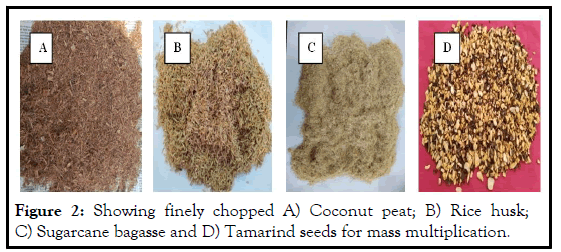
Figure 2: Showing finely chopped A) Coconut peat; B) Rice husk; C) Sugarcane bagasse and D) Tamarind seeds for mass multiplication.
Mass multiplication: 20 gm of each waste material and 50 ml distilled water was taken in 250 ml conical flask and plugged with cotton plug. Now, autoclaved them at 15 psi for 30 min. After cooling, 1 ml spore suspension of the seven days old fungal culture was inoculated into each flask under laminar air flow chamber. Initial weight of all flask with waste material was noted. They were incubated at 26℃ ± 2℃ for 21 days. After 7 days of inoculation, the flasks were shaken vigorously to break the mycelia mat and avoid clumping. After 21 days, final weight of flask was noted and biomass of Trichoderma was obtained.
Plant growth promotion activity
Two trays with ten pots were taken. First tray pots were filled only with soil and second were filled with T. yunnanense mixed soil. Tomato seeds were sown in both tray pots. Two months after sowing, five tomato plants were uprooted randomly from each tray and observations were made on length (plant, stem and root), weight (fresh and dry) and total chlorophyll content [20].
Pathogenicity tests
Different isolates of Fusarium, Alternaria, Aspergillus and Penicillium were obtained from potato, cabbage and soil samples. The study was carried out over two successive years 2021 and 2022 in different agricultural zone of Patna, Gaya, Ara and Nalanda district of Bihar. The most virulent isolate was chosen for the biocontrol tests.
Molecular identification and phylogenetic analysis
Twenty three isolates of seven different species with macroscopic and microscopic characteristics of the genus Trichoderma were isolated from the different soil samples collected. T. yunnanense which was reported as new finding in Bihar was identified on the basis of ITS sequencing (accession No. OP850269.1). BLAST search of the sequences obtained during this work was performed and the results with the highest similarity percentages obtained in this study were selected for species identification. The maximum likelihood approach was used to determine the phylogenetic relation between selected sequences of NCBI database. The isolated strain was closely related to T. yunnanense (Figure 3).
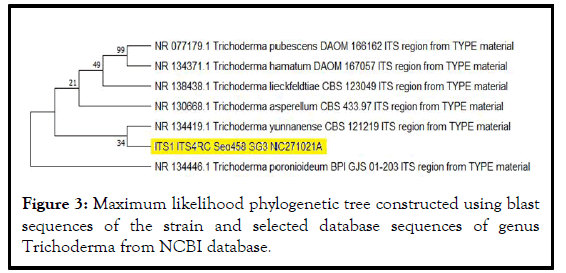
Figure 3: Maximum likelihood phylogenetic tree constructed using blast sequences of the strain and selected database sequences of genus Trichoderma from NCBI database.
The evolutionary history was inferred using the Neighbor-Joining method. The bootstrap consensus tree inferred from 500 replicates Felsenstein, et al. is taken to represent the evolutionary history of the taxa analyzed. Branches corresponding to partitions reproduced in less than 50% bootstrap replicates are collapsed. The percentage of replicate trees in which the associated taxa clustered together in the bootstrap test (500 replicates) are shown next to the branches. The evolutionary distances were computed using the maximum composite likelihood method Tamura, et al. and are in the units of the number of base substitutions per site. This analysis involved 7 nucleotide sequences. All ambiguous positions were removed for each sequence pair (pairwise deletion option). There were a total of 630 positions in the final dataset. Evolutionary analyses were conducted in MEGA11. The sequence from the analyzed strain is in yellow.
In vitro antagonistic test by dual-culture technique
In the dual culture test, T. yunnanense inhibited the mycelial growth of the most virulent isolates of F. solani, A. brassicae, A. flavus and P. notatum as compared to the control without Trichoderma with a range varying from 68% to 94% on PDA medium (Figure 4 and Table 1).
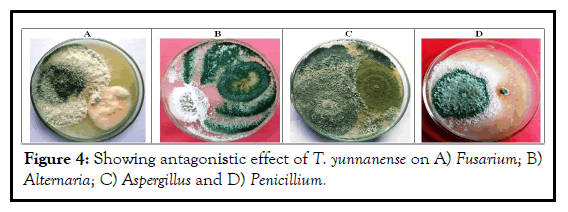
Figure 4: Showing antagonistic effect of T. yunnanense on A) Fusarium; B) Alternaria; C) Aspergillus and D) Penicillium.
| Pathogens | Mycelial growth (in mm) | Inhibition percent over control | Days of mycelial overgrowth of T. yunnanense | Growth of pathogens in control (in mm) |
|---|---|---|---|---|
| Fusarium solani | 2.8 | 68.88 | 7 | 9 |
| Alternaria brassicae | 2.3 | 74.44 | 5 | 9 |
| Aspergillus flavus | 3.2 | 64.44 | 11 | 9 |
| Penicillum notatum | 0.5 | 94.44 | 4 | 7.2 |
TABLE 1: Antagonistic activity of T. yunnanense against soil borne pathogens in dual culture after seven days.
Effect of crude extract of secondary metabolites
Total six secondary metabolites were observed on TLC plate (Figure 5). The Rf value of secondary metabolites were ranged between 0.41 to 0.93 cm. The secondary metabolites were inhibited the growth of all pathogens. The isolated secondary metabolite with Rf value 0.76, 0.66 and 0.53 show the more inhibition of mycelial growth of the pathogen than the Rf value 0.93, 0.46 and 0.41 (Table 2).
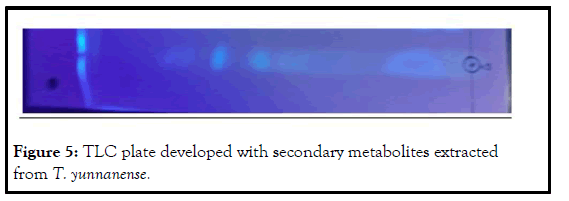
Figure 5: TLC plate developed with secondary metabolites extracted from T. yunnanense.
| Sl. No. | Percent of growth inhibition | ||||
|---|---|---|---|---|---|
| Rf value | Fusarium | Alternaria | Aspergillus | Penicillium | |
| 1 | 0.41 | 14 | 20 | 11 | 17 |
| 2 | 0.46 | 32 | 32 | 26 | 39 |
| 3 | 0.53 | 62 | 78 | 51 | 91 |
| 4 | 0.66 | 57 | 62 | 32 | 84 |
| 5 | 0.76 | 76 | 87 | 47 | 93 |
| 6 | 0.93 | 27 | 31 | 13 | 47 |
TABLE 2: Percent growth inhibition of different pathogens by secondary metabolites isolated from T. yunnanense
Mass multiplication
It was observed that, the growth rate was highest on tamarind seeds and sugarcane bagasse followed by coconut peat. Least mycelia growth was recorded on rice husk after 21 days of incubation (Figures 6 and 7).
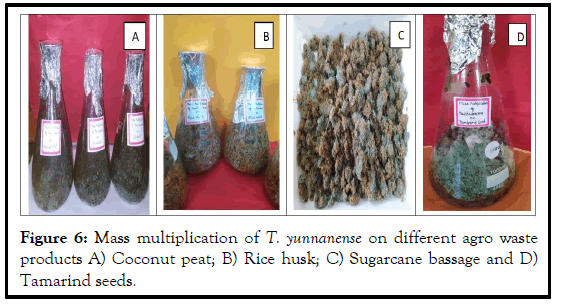
Figure 6: Mass multiplication of T. yunnanense on different agro waste products A) Coconut peat; B) Rice husk; C) Sugarcane bassage and D) Tamarind seeds.
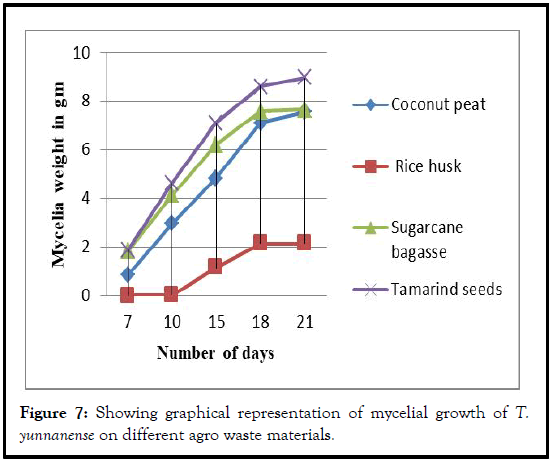
Figure 7: Showing graphical representation of mycelial growth of T. yunnanense on different agro waste materials.
This result shows that Trichoderma is capable to grow and sporulate on different agro waste products and different agricultural waste materials can be used as valuable material for mass multiplication of bio control agent.
Growth promotion
Pot experiment was done to evaluate the growth promotion activity of T. yunnanense (Figure 8). The plants with T. yunnanense treatment showed significant increase in overall plant growth as compare to untreated plants (Table 3). Thus, the qualitative growth promotion assessment showed that T. yunnanense grown on agro-waste was feasible bio-control agent for application in soil.
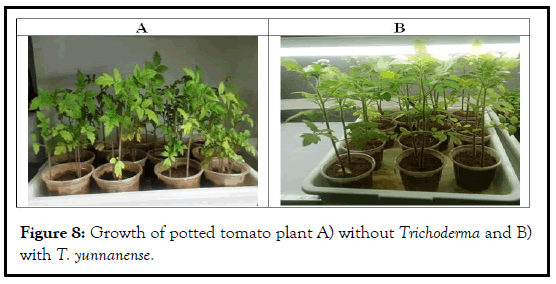
Figure 8: Growth of potted tomato plant A) without Trichoderma and B) with T. yunnanense.
| Plant growth parameters | Untreated | Treated | |
|---|---|---|---|
| Length (cm) | Plant | 16.5 ± 0.8 | 23.7 ± 1.15 |
| Stem | 3.17 ± 0.83 | 4.97 ± 0.87 | |
| Root | 4.58 ± 1.23 | 5.67 ± 0.29 | |
| Fresh | 3.38 ± 0.02 | 4.58 ± 0.01 | |
| Weight (gm) | Dry | 1.23 ± 0.007 | 2.32 ± 0.001 |
| Total chlorophyll content | 0.225 ± 1.15 | 0.463 ± 1.90 | |
| Values are means of five replicates. ± standard deviation. | |||
TABLE 3: Efficacy of T. yunnanense on growth parameter of tomato plants .
Trichoderma spp. produce various metabolites which induce systemic resistance in plant, such as xylanase, low molecular-weight compounds produced either from fungal cell walls and virulence like gene products. Various low molecular-weight products from fungal cell walls have been characterized. They have been reported for elicitation of defense reaction in the host plant when applied to roots or leaves. The beneficial effect of several Trichoderma secondary metabolites on plant growth and development has been reported. On inoculated plants, plant height and root length were slightly increased, suggesting that T. yunnanense began to promote tomato growth at an early stage of the growth process. According to numerous studies, Trichoderma spp. can enhance plant growth and development by producing growth hormones like IAA and GA3. Generally, numerous recent and older studies Ousley, et al.; Saba, et al.; Stewart, et al.; Bora, et al.; Sanchez, et al.; Inbar, et al.; Poveda, et al.; Fontenelle, et al. have clearly demonstrated the capacity of Trichoderma to stimulate plant growth under various biotic and abiotic stress conditions. Trichoderma stimulates phosphorus mobilization by extracellular phosphatases, the production of indole-3-acetic acid derivatives, and other plant growth mechanisms.
Fontenelle, et al. evaluated 28 isolates of Trichoderma in analysis of growth promotion and to antagonize Alternaria solani. Kumar, et al. analysed twelve isolates of Trichoderma from South Andaman for their antagonistic potential against soil borne and foliar borne pathogens. In 2013, Qualhato, et al. tested four species of Trichoderma against Fusarium solani.
Enzyme production is one of the most important applications of Solid State Fermentation (SSF). The use of agricultural wastes as the basis for the cultivation media in SSF is a matter of great interest, which aims to minimize the costs of energy production and meeting the increase in awareness on energy conservation and recycling. Substrates such as agricultural residues are proved by many researchers to be better for filamentous fungi. The morphology of filamentous fungi supports them to penetrate the hardest surface due to the presence of turgid pressure at the tip of their mycelium. Therefore, Solid State Fermentation (SSF) is finding increasing application in the production of value added products from wastes mostly from agro-industry.
Based on the finding of this study, it is concluded that there is possibility to control the diseases in plants caused by Alternaria, Fusarium, Aspergillus, Penicillium using T. yunnanense isolates obtained from Bihar. These results also confirmed the effectiveness of native strains in biological control and growth promotion leading to a better preservation of soil microbial diversity, because the strains already exist in the soil microbial complex. T. yunnanense is very effective species to control different fungal pathogenic diseases as well as it also helps in the overall growth of plant.
It is also concluded that, agro-waste products can be used as negative cost materials for mass multiplication of bio-control agent. The plant growth promotion activity showed that T. yunnanense produced on agro-waste products is active even in soil. Therefore, this process possesses characteristics of a potential bio-control agent for commercial production. It will improve the soil health and decrease the use of chemicals in agricultural sectors.
We thank to staff members of department of botany, Patna university, Patna for their support.
The authors declare that they have no known competing financial interest that influence the work reported here.
The research did not receive any specific grant from any funding agency.
As no mammalian subjects were involved in this research, no ethical approval was required.
All authors concent to publication.
[Crossref] [Google Scholar] [PubMed]
[Crossref] [Google Scholar] [PubMed]
[Crossref] [Google Scholar] [PubMed]
[Crossref] [Google Scholar] [PubMed]
[Crossref] [Google Scholar] [PubMed]
[Crossref] [Google Scholar] [PubMed]
[Crossref] [Google Scholar] [PubMed]
[Crossref] [Google Scholar] [PubMed]
[Crossref] [Google Scholar] [PubMed]
[Crossref] [Google Scholar] [PubMed]
[Crossref] [Google Scholar] [PubMed]
Citation: Kumari S, Sharfuddin C. Bio-control potential of Trichoderma yunnanense against phytopathogenic fungi and growth promotion activity after mass multiplication using agro-waste products. AGBIR.2024;40(3):1091-1095.
Received: 04-Mar-2023, Manuscript No. AGBIR-23-90927; , Pre QC No. AGBIR-23-90927 (PQ); Editor assigned: 07-Mar-2023, Pre QC No. AGBIR-23-90927 (PQ); Reviewed: 21-Mar-2023, QC No. AGBIR-23-90927; Revised: 04-May-2023, Manuscript No. AGBIR-23-90927 (R); Published: 13-May-2024, DOI: 10.37532/0970-1907.24.40.1091-1095
